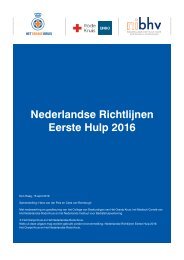Thesis-Anne-Vos-Masters-SBR-and-EU-Law-3
Thesis-Anne-Vos-Masters-SBR-and-EU-Law-3
Thesis-Anne-Vos-Masters-SBR-and-EU-Law-3
You also want an ePaper? Increase the reach of your titles
YUMPU automatically turns print PDFs into web optimized ePapers that Google loves.
this zone is made available. Also, it should be reminded that once ground water or drinking water is<br />
contaminated, it is very difficult to clean this. Moreover, when looking at the interest of drinking<br />
water in combination with the precautionary principle, it is very clear that if certain risks are taken,<br />
this must comply with the condition that this must be acceptable to the society on which the risk is<br />
imposed. Here, this is very questionable. It could be wondered whether it fits better with those<br />
principles to exclude those areas completely <strong>and</strong> moreover, to also exclude the bore free zones<br />
<strong>and</strong> all the areas appointed by the province, which are currently (in principle) not excluded by the<br />
Draft MSL. Hence, the Draft MSL does take the drinking water areas into account, but not in a way<br />
that is deemed acceptable to the society <strong>and</strong> not sufficiently with regard to the 1000 metres zone<br />
<strong>and</strong> non-exclusion of the bore free zones.<br />
With regard to this problem (concerning the conflicting interests), the problem of overriding<br />
authorities <strong>and</strong> the dilemma of the balancing of two national interests (already touched upon in<br />
paragraph 6.1.3) come into play. It is a difficult <strong>and</strong> tricky operation to balance the national interest<br />
of energy security against the national interest of the protection of groundwater <strong>and</strong> drinking water<br />
resources. What could play a role is the precautionary principle. With regard to the contamination<br />
of ground water it could be stated that it is very difficult (if not impossible) to resolve this. Also, the<br />
risks are not entirely clear. Moreover, with regard to drinking water, it should be mentioned that<br />
there is no alternative, while for the security of energy supply there is. Except for groundwater <strong>and</strong><br />
surface water, there is no alternative for drinking water. If precaution <strong>and</strong> prevention play a role<br />
(<strong>and</strong> the concept of sustainable development), it is also important to look ahead; what is possible in<br />
20 years? It is possible to switch to renewable energy, but there is nothing to switch to with regard<br />
to drinking water (except for the desalination of the sea, which again would cost a lot of energy).<br />
So there is no alternative in the long- term. It could therefore be argued that the State should act its<br />
overriding powers when it comes to the protection of drinking water, not for the protection of shale<br />
gas extraction.<br />
Finally, as pointed out in Chapter 3, there are problems with regard to the fragmentised nature of<br />
the legislation, which could result in gaps in legislation. This latter could decrease environmental<br />
protection. This is also a great concern of the society (as shown by Chapter 2 <strong>and</strong> the broad public<br />
consultation). It could be wondered whether the precautionary <strong>and</strong> prevention principles could<br />
require a more centralised or clear legislation to establish that there are no gaps in the legislation.<br />
This also applies to the fragmentation of assessment frameworks, where it is remarkable that the<br />
Mining Act does not involve environmental requirements. It would not be the first time that the<br />
precautionary <strong>and</strong> prevention principles are used as an argument to adopt or adjust legislation. The<br />
precautionary principle has for example also been used as an argument (prior to the adoption of<br />
the Recommendation) in order to defer shale gas projects to an EIA. 430<br />
6.5 Concept of sustainable development<br />
As set out in Paragraph 5.8, the sustainable impact assessment – developed by Van Hees – can<br />
offer another way (an extra check) of reviewing whether the current <strong>and</strong> upcoming shale gas<br />
regulation is line with a certain environmental, sustainable manner of thinking. In this paragraph<br />
this sustainable impact assessment will be carried out.<br />
The first question to answer is whether the decision to extract shale gas has negative<br />
consequences for policy objectives such as the protection of a high level of quality of the<br />
environment <strong>and</strong> public health <strong>and</strong> for the protection of fundamental rights. This can be answered<br />
in the affirmative. Shale gas extraction can lead to higher emissions, contamination of groundwater<br />
<strong>and</strong> drinking water, seismicity, etc. This can all lead to negative consequences for the protection of<br />
the environment <strong>and</strong> public health.<br />
430<br />
Douma (2014), p. 50.<br />
92



